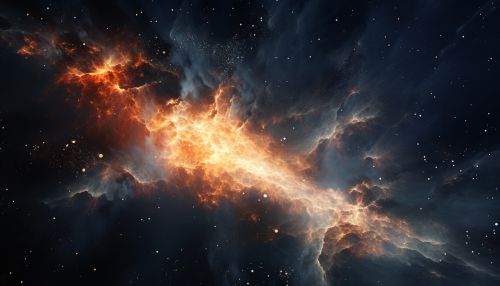Fragmentation (Astrophysics)
Introduction
Fragmentation in astrophysics refers to the process through which matter, typically in the form of gas clouds, breaks down into smaller pieces. This phenomenon is a critical aspect of star formation, as it leads to the creation of dense cores that eventually collapse under their own gravity to form stars. Fragmentation is a complex process influenced by a variety of factors, including the initial conditions of the gas cloud, the influence of magnetic fields, and the effects of turbulence.


Mechanisms of Fragmentation
The primary mechanism for fragmentation in astrophysics is gravitational instability. When a gas cloud's self-gravity overcomes the forces resisting it, such as thermal pressure and magnetic fields, it begins to collapse. As the cloud collapses, it fragments into smaller pieces, each of which may continue to collapse on its own. This process is known as Jeans instability, named after the British physicist Sir James Jeans who first described it.
Another important mechanism is turbulent fragmentation. Turbulence within a gas cloud can create dense regions that then collapse under their own gravity. This process is particularly relevant in the early stages of star formation, where turbulence is thought to play a significant role.
Factors Influencing Fragmentation
Several factors influence the fragmentation process, including the initial conditions of the gas cloud, the influence of magnetic fields, and the effects of turbulence.
Initial Conditions
The initial conditions of a gas cloud, such as its mass, size, and temperature, can significantly influence the fragmentation process. For instance, a larger, more massive cloud is more likely to fragment than a smaller, less massive one. Similarly, a cooler cloud is more likely to fragment than a hotter one, as the thermal pressure resisting collapse is lower.
Magnetic Fields
Magnetic fields can also influence the fragmentation process. They can provide additional support against gravitational collapse, thereby influencing the size and mass of the fragments. In some cases, magnetic fields can also induce fragmentation, for example, through a process known as magnetic braking.
Turbulence
Turbulence within a gas cloud can also influence fragmentation. Turbulence can create dense regions within the cloud that are more prone to collapse, thereby promoting fragmentation. On the other hand, turbulence can also provide support against collapse, thereby inhibiting fragmentation.
Fragmentation and Star Formation
Fragmentation plays a crucial role in star formation. The dense cores formed through fragmentation are the sites where stars are born. These cores collapse under their own gravity, forming protostars that eventually evolve into stars.
The mass of the fragments can determine the mass of the resulting stars. For instance, larger fragments can form more massive stars, while smaller fragments can form less massive stars. This relationship is known as the initial mass function.
Conclusion
Fragmentation is a complex and multifaceted process that plays a crucial role in star formation. It is influenced by a variety of factors, including the initial conditions of the gas cloud, the influence of magnetic fields, and the effects of turbulence. Understanding this process is key to understanding the birth and evolution of stars.
